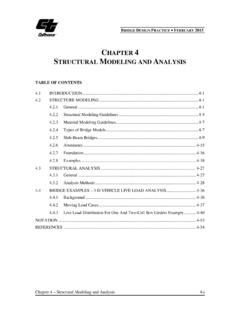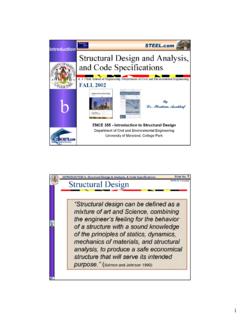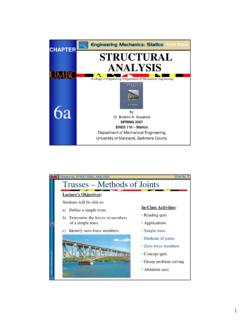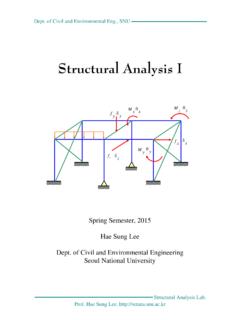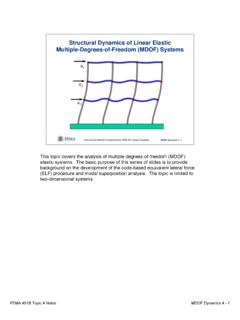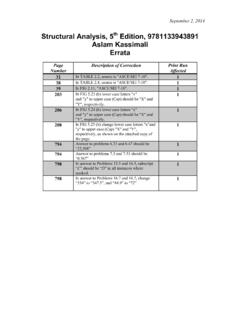Transcription of Chapter 4 Static Structural Analysis - etu.edu.tr
1 Workbench - Mechanical Introduction Chapter 4. Static Structural Analysis ANSYS, Inc. Proprietary May 5, 2009. 2009 ANSYS, Inc. All rights reserved. 4-1 Inventory #002593. Static Structural Analysis Chapter Overview Training Manual In this Chapter , performing linear Static Structural analyses in Simulation will be covered: A. Geometry and Elements B. Assemblies and Contact Types C. Analysis Settings D. Environment, including Loads and Supports E. Solving Models F. Results and Postprocessing The capabilities described in this section are generally applicable to ANSYS DesignSpace Entra licenses and above. Some options discussed in this Chapter may require more advanced licenses, but these are noted accordingly. ANSYS, Inc. Proprietary May 5, 2009. 2009 ANSYS, Inc. All rights reserved. 4-2 Inventory #002593.
2 Static Structural Analysis Basics of Linear Static Analysis Training Manual For a linear Static Structural Analysis , the displacements {x} are solved for in the matrix equation below: [K ]{x} = {F}. Assumptions: [K] is constant Linear elastic material behavior is assumed Small deflection theory is used Some nonlinear boundary conditions may be included {F} is statically applied No time-varying forces are considered No inertial effects (mass, damping) are included It is important to remember these assumptions related to linear Static Analysis . Nonlinear Static and dynamic analyses are covered in later chapters. ANSYS, Inc. Proprietary May 5, 2009. 2009 ANSYS, Inc. All rights reserved. 4-3 Inventory #002593. Static Structural Analysis A. Geometry Training Manual In Structural analyses, all types of bodies supported by Simulation may be used.
3 For surface bodies, thickness must be supplied in the Details view of the Geometry branch. The cross-section and orientation of line bodies are defined within DesignModeler and are imported into Simulation automatically. ANSYS, Inc. Proprietary May 5, 2009. 2009 ANSYS, Inc. All rights reserved. 4-4 Inventory #002593. Static Structural Analysis Point Mass Training Manual A Point Mass can be added to a model (Geometry branch) to simulate parts of the structure not explicitly modeled: A point mass is associated with surface(s) only. The location can be defined by either: (x, y, z) coordinates in any user-defined Coordinate System. Selecting vertices/edges/surfaces to define location. Point mass is affected by Acceleration, Standard Earth Gravity, and Rotational Velocity . No other loads affect a point mass.
4 The mass is connected' to selected surfaces assuming no stiffness between them. No rotational inertial terms are present. ANSYS, Inc. Proprietary May 5, 2009. 2009 ANSYS, Inc. All rights reserved. 4-5 Inventory #002593. Static Structural Analysis Material Properties Training Manual Young's Modulus and Poisson's Ratio are required for linear Static Structural analyses: Material input is handled in the Engineering Data application. Mass density is required if any inertial loads are present. Thermal expansion coefficient is required if a uniform temperature load is applied. Thermal conductivity is NOT required for uniform temperature conditions. Stress Limits are needed if a Stress Tool result is present. Fatigue Properties are needed if Fatigue Tool result is present. Requires Fatigue Module add-on license.
5 ANSYS, Inc. Proprietary May 5, 2009. 2009 ANSYS, Inc. All rights reserved. 4-6 Inventory #002593. Static Structural Analysis B. Assemblies Solid Body Contact Training Manual When importing assemblies of solid parts, contact regions are automatically created between the solid bodies. Contact allows non-matching meshes at boundaries between solid parts Tolerance controls under Contact branch allows the user to specify distance of auto contact detection via slider bar ANSYS, Inc. Proprietary May 5, 2009. 2009 ANSYS, Inc. All rights reserved. 4-7 Inventory #002593. Static Structural Analysis Assemblies Solid Body Contact Training Manual In Simulation, the concept of contact and target surfaces are used for each contact region: One side of a contact region is referred to as a contact surface, the other side is referred to as a target surface.
6 The contact surfaces are restricted from penetrating through the target surface. When one side is designated the contact and the other side the target, this is called asymmetric contact. If both sides are made to be contact & target this is called symmetric contact. C. By default, Simulation usesTsymmetric contact for solid assemblies. For ANSYS Professional licenses and above, the user may change to asymmetric contact, as desired. Symmetric Asymmetric Contact Contact ANSYS, Inc. Proprietary May 5, 2009. 2009 ANSYS, Inc. All rights reserved. 4-8 Inventory #002593. Static Structural Analysis Assemblies Solid Body Contact Training Manual Five contact types are available: Contact Type Iterations Normal Behavior (Separation) Tangential Behavior (Sliding). Bonded 1 No Gaps No Sliding No Separation 1 No Gaps Sliding Allowed Frictionless Multiple Gaps Allowed Sliding Allowed Rough Multiple Gaps Allowed No Sliding Frictional Multiple Gaps Allowed Sliding Allowed Bonded and No Separation contact are linear and require only 1 iteration.
7 Frictionless, Rough and Frictional contact are nonlinear and require multiple iterations. Nonlinear contact types allow an interface treatment . option: Add Offset : input zero or non-zero value for initial adjustment Adjusted to Touch : ANSYS closes any gap to a just touching position (ANSYS Professional and above). ANSYS, Inc. Proprietary May 5, 2009. 2009 ANSYS, Inc. All rights reserved. 4-9 Inventory #002593. Static Structural Analysis Assemblies Solid Body Contact Training Manual Interface treatment options: C C T. T. Add offset: contact surface is Adjusted to touch: offsets contact numerically offset a given amount surface to provide initial contact in positive or negative direction with target regardless of actual (offset can be ramped on). gap/penetration. ANSYS, Inc. Proprietary May 5, 2009.
8 2009 ANSYS, Inc. All rights reserved. 4-10 Inventory #002593. Static Structural Analysis Assemblies Solid Body Contact Training Manual Advanced options (see Chapter 3. for additional details on the pinball region): Pin Ball Region: Inside pinball = near-field contact Outside pinball = far-field contact Allows the solver to more efficiently process contact calculations. For ANSYS Professional licenses and above, mixed assemblies of shells and solids are supported as well as more contact options. In this case, the gap between the two parts is bigger than the pinball region, so no automatic gap closure will be performed. ANSYS, Inc. Proprietary May 5, 2009. 2009 ANSYS, Inc. All rights reserved. 4-11 Inventory #002593. Static Structural Analysis Assemblies Spot Weld Training Manual Spot welds provide a means of connecting shell assemblies at discrete points: Spotweld definition is done in the CAD software.
9 Currently, only DesignModeler and Unigraphics define supported spot weld definitions. ANSYS, Inc. Proprietary May 5, 2009. 2009 ANSYS, Inc. All rights reserved. 4-12 Inventory #002593. Static Structural Analysis Assemblies Contact Summary Training Manual Summary of contact types and options available in Simulation: Contact Geometry Solid Body Face Solid Body Edge Surface Body Face Surface Body Edge (Scope = Contact) (Scope = Contact) (Scope = Contact) (Scope = Contact). Solid Body Face All types Bonded, No Separation Bonded, No Separation Bonded only All formulations All formulations All formulations MPC formulation (Scope = Target) Symmetry respected Asymmetric only Symmetry respected Asymmetric only Solid Body Edge Not supported for solving1 Bonded, No Separation Not supported for solving1 Bonded only All formulations MPC formulation (Scope = Target) Asymmetric only Asymmetric only Surface Body Face Bonded, No Separation Bonded, No Separation Bonded, No Separation Bonded only Augmented Lagrange, (Scope = Target) All formulations All formulations All formulations Pure Penalty, and MPC.
10 Formulation Symmetry respected Asymmetric only Symmetry respected Asymmetric only Surface Body Edge Not supported for solving1 Bonded only Not supported for solving1 Bonded only Augmented Lagrange, (Scope = Target) MPC formulation Pure Penalty, and MPC. formulation Asymmetric only Asymmetric only 1 For Face/Edge contact, faces must always be designated as targets and edges must always be designated as contacts ANSYS, Inc. Proprietary May 5, 2009. 2009 ANSYS, Inc. All rights reserved. 4-13 Inventory #002593. Static Structural Analysis C. Analysis Settings Training Manual The Analysis Settings details provide general control over the solution process: Step Controls: Manual and auto time stepping controls. Specify the number of steps in an Analysis and an end time for each step. Time is a tracking mechanism in Static analyses (discussed later).


